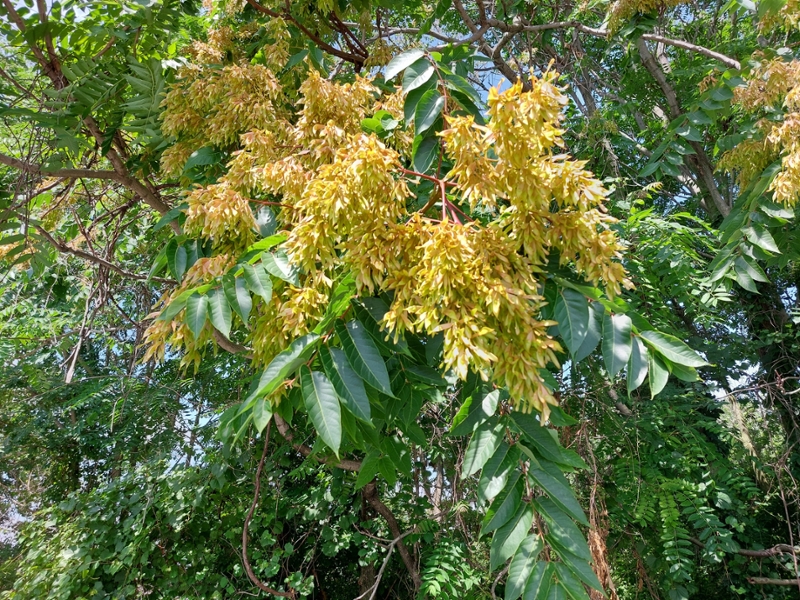Last August, I penned an article about identifying tree-of-heaven (ToH), a favorite host of one of Indiana’s newest invasive insects, the spotted lanternfly. Recently, Purdue Extension has released a new comprehensive publication on tree-of-heaven, authored by Lenny Farlee, Ron Rathfon, Don Carlson, and Brian Beheler.
I’ll only briefly rehash a few details about identifying tree-of-heaven. It has compound leaves with 11-41 leaflets that can reach up to 2½ feet long. ToH leaflets have what we call “glandular teeth” at the base of an otherwise nearly smooth or entire leaf margin. The tree can get up to 80 feet tall. We commonly find this tree along railroad corridors and similar areas. It is present throughout Indiana. Originally from China, this tree was reportedly introduced about 1784 in Philadelphia, PA.
We’re concerned about tree-of-heaven, Ailanthus altissima, for its environmental impacts. I already mentioned it being a favorite host of spotted lanternfly, but it is also an invasive plant. In fact, it is so invasive that it is one of the plants included in Indiana’s Terrestrial Plant Rule (312 IAC 18-3-25), which makes it illegal to sell, gift, barter, exchange, distribute, transport, or introduce these plants in the State of Indiana. It’s appropriate to discuss ToH this week, as Governor Eric Holcomb has proclaimed February 25th to March 2nd as 2024 Invasive Species Awareness Week in Indiana.
Even though you won’t find this plant at a nursery or garden store, it’s here and it spreads effectively on its own. “The numerous windblown seed, prolific root sprouting, rapid growth rate and allelopathic chemical production make ToH a serious threat as an invasive species in many habitats or untended areas,” wrote the Purdue authors. “ToH roots may damage roads, sidewalks, foundations, and other infrastructure.”
An allelopathic chemical is one that discourages the growth of nearby plants.
The authors stated that controlling tree-of-heaven can be challenging. Methods include mechanical (pulling, cutting or girdling stems), fire, and chemical treatments. The authors indicated that mechanical treatments alone are not typically effective against ToH. Root fragments remaining after pulling, and stump and root sprouts after cutting or girdling can result in new plants. After fire, the remaining root systems may produce abundant sprouts.
Chemical control methods include basal bark applications, hack and squirt applications, cut-stump treatments, and foliar applications. “For very dense or large infestations, using tree and brush clearing equipment, such as rotary grinders mounted to skid-steer machines, may be the most efficient approach to start the control process,” they said. “Since root systems are not controlled using this approach, a follow-up foliar herbicide treatment of all sprouts will be needed the next growing season.”
Researchers are experimenting with biological controls for ToH, particularly using the fungus that causes Verticillium nonalfalfae wilt. While it shows potentially promising results on ToH, the research must also evaluate negative impacts on non-target plants, which will take time.
Find the referenced publication, number FNR-633-W, at Purdue Extension’s Education store, www.edustore.purdue.edu.

Female tree-of-heaven with seed load. Photo by John E. Woodmansee